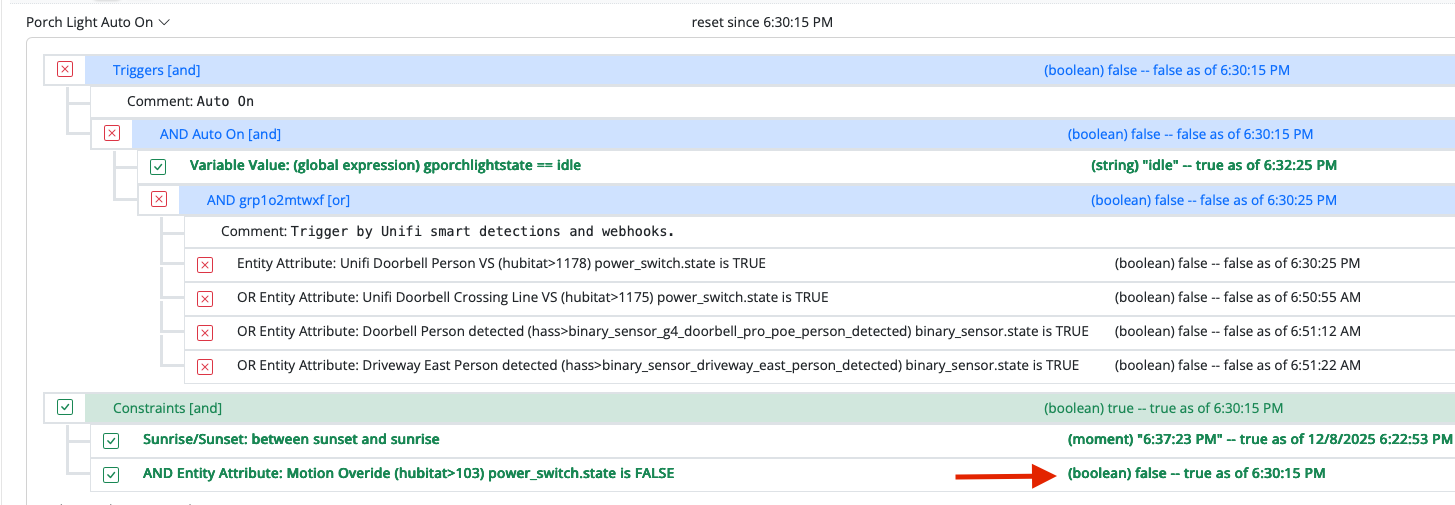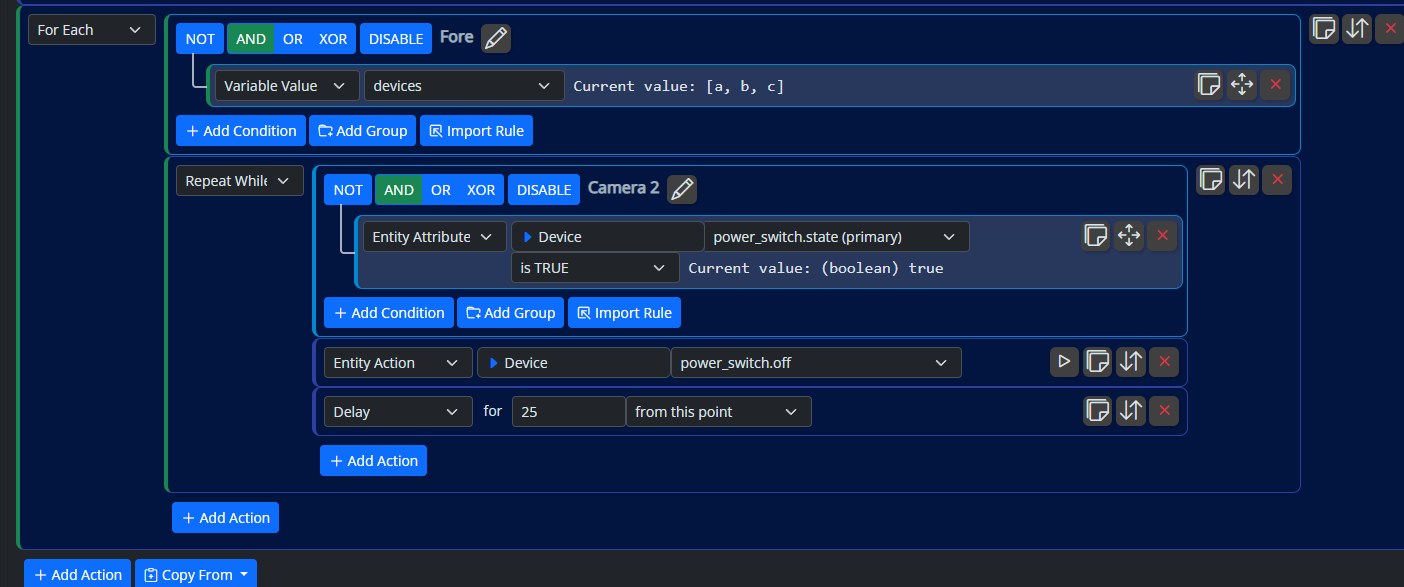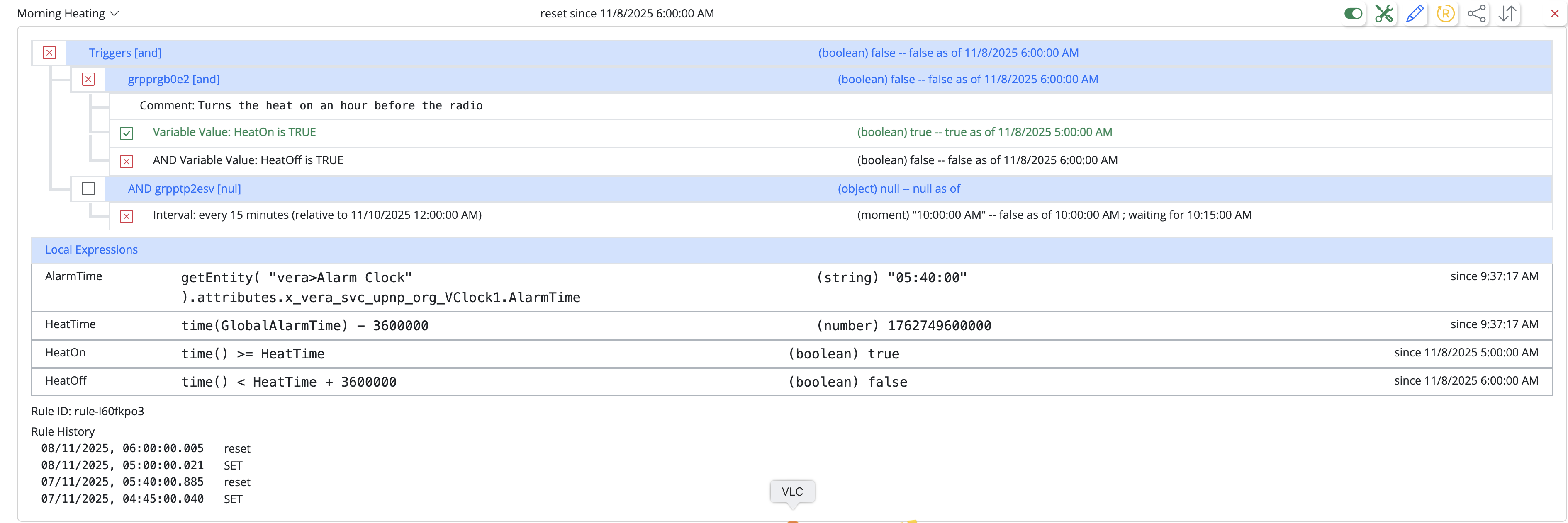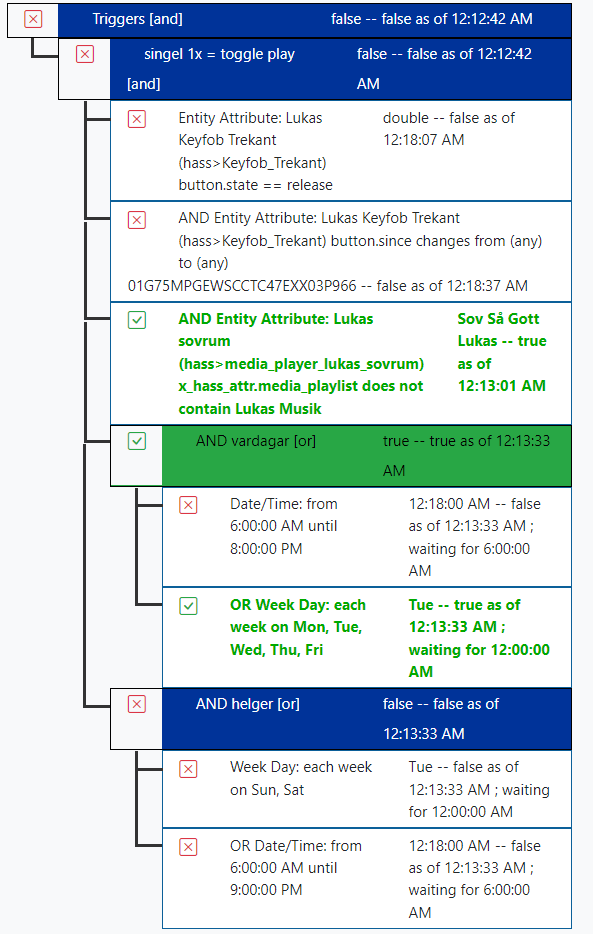Adding remotes, scene controllers as entities to MSR
-
But, still, I can't for some reason really understand the code and how different parts relate to each other.
The
eventsection is a filter to look for a specific event. In your version, you have multiplevaluekeys, which is not allowed. Also, you don't want to filter by value, just accept them all and let theresponsesection deal with them. I recommended against usinglabelbecause it's changeable in ZWave, whereas thepropertyandproperty_keyvalues are defined by the device and will not change.So again, the
eventsection is the filter that determines what incoming event will match, and what will not.Once an event matches, the
responsesection determines what to do with it. Each component of theresponsesection is an attribute of an assigned capability and the instructions to set it. In the case ofbutton.state, my version says grab the valuefrom event.data.value, and then,mapthat value from the device's string to one of Reactor's accepted capability/attribute value. Settingbutton.sincecompletes the "contract" of thebuttoncapability (i.e. makes it work like similar uses ofbuttonin other devices and related to other controllers). I'm not sure I can explain it more simply than that.It's really just a "if you find this... do this" configuration. The effect is that if a matching button event is detected by the
eventsection, theresponsesection will interpet the value and map it to a Reactor-compatible value to place on the entity attributebutton.state, and also update thebutton.sincetimestamp. Thus thesincetimestamp changes every time a button press event is received, butstatemay not change, because it's possible to press a button once, wait 15 seconds, and press the same button again, which will result in the valuesinglebeing persistent on thestateattribute and not changing. So to detect an event, you have to check bothstateandsince(and this is consistent with allbuttonbehavior in Reactor).To test button state in a rule, you test
button.statefor what you want in that rule (equalssingle,double,triple), and you AND that test with abutton.sincechanges (from any to any). That will send a very short pulse when a matching button press occurs. While testing, to make sure you can see it, add a "sustained for" delay on the changes condition of a few seconds (keep it short), and you'll more easily see what's going on in the status view. Make sure to remove the delay when you're done playing (keeping it will dampen response to buttons when, for example, a single press is done repeatedly within the delay period).Example here: https://smarthome.community/assets/uploads/files/1646184651741-cbff18f3-ce2d-4ecd-ae65-2554f77a4a80-image.png
-
But, still, I can't for some reason really understand the code and how different parts relate to each other.
The
eventsection is a filter to look for a specific event. In your version, you have multiplevaluekeys, which is not allowed. Also, you don't want to filter by value, just accept them all and let theresponsesection deal with them. I recommended against usinglabelbecause it's changeable in ZWave, whereas thepropertyandproperty_keyvalues are defined by the device and will not change.So again, the
eventsection is the filter that determines what incoming event will match, and what will not.Once an event matches, the
responsesection determines what to do with it. Each component of theresponsesection is an attribute of an assigned capability and the instructions to set it. In the case ofbutton.state, my version says grab the valuefrom event.data.value, and then,mapthat value from the device's string to one of Reactor's accepted capability/attribute value. Settingbutton.sincecompletes the "contract" of thebuttoncapability (i.e. makes it work like similar uses ofbuttonin other devices and related to other controllers). I'm not sure I can explain it more simply than that.It's really just a "if you find this... do this" configuration. The effect is that if a matching button event is detected by the
eventsection, theresponsesection will interpet the value and map it to a Reactor-compatible value to place on the entity attributebutton.state, and also update thebutton.sincetimestamp. Thus thesincetimestamp changes every time a button press event is received, butstatemay not change, because it's possible to press a button once, wait 15 seconds, and press the same button again, which will result in the valuesinglebeing persistent on thestateattribute and not changing. So to detect an event, you have to check bothstateandsince(and this is consistent with allbuttonbehavior in Reactor).To test button state in a rule, you test
button.statefor what you want in that rule (equalssingle,double,triple), and you AND that test with abutton.sincechanges (from any to any). That will send a very short pulse when a matching button press occurs. While testing, to make sure you can see it, add a "sustained for" delay on the changes condition of a few seconds (keep it short), and you'll more easily see what's going on in the status view. Make sure to remove the delay when you're done playing (keeping it will dampen response to buttons when, for example, a single press is done repeatedly within the delay period).Example here: https://smarthome.community/assets/uploads/files/1646184651741-cbff18f3-ce2d-4ecd-ae65-2554f77a4a80-image.png
Ok, I understood it at first that I needed to specify more stuff in the event section, like 'value' so it then could be mapped to right command, otherwise it would not be known.
But nodeid, property and property key is just to filter out right device, all the other data is still there?
And in that case, I guess that it would work to skip event data and just mapping commands to MSR functions? (Of course nothing else can send 'Keypressed' command because that would be messy) -
Ok, I understood it at first that I needed to specify more stuff in the event section, like 'value' so it then could be mapped to right command, otherwise it would not be known.
But nodeid, property and property key is just to filter out right device, all the other data is still there?
And in that case, I guess that it would work to skip event data and just mapping commands to MSR functions? (Of course nothing else can send 'Keypressed' command because that would be messy)@andr said in Adding remotes, scene controllers as entities to MSR:
But nodeid, property and property key is just to filter out right device, all the other data is still there?
That's right. The
eventsection only filters using the data; it does not modify the data or transform it in any way. Whatever is received in the event structure stays as received.@andr said in Adding remotes, scene controllers as entities to MSR:
And in that case, I guess that it would work to skip event data and just mapping commands to MSR functions?
I'm not sure what you mean by this. I don't think you want to skip anything. You should filter the incoming events, to make sure that you are handling the right events from the right device. So you need to be specific in the
eventfilter to both the event type and the sending device. -
@andr said in Adding remotes, scene controllers as entities to MSR:
But nodeid, property and property key is just to filter out right device, all the other data is still there?
That's right. The
eventsection only filters using the data; it does not modify the data or transform it in any way. Whatever is received in the event structure stays as received.@andr said in Adding remotes, scene controllers as entities to MSR:
And in that case, I guess that it would work to skip event data and just mapping commands to MSR functions?
I'm not sure what you mean by this. I don't think you want to skip anything. You should filter the incoming events, to make sure that you are handling the right events from the right device. So you need to be specific in the
eventfilter to both the event type and the sending device.@toggledbits said in Adding remotes, scene controllers as entities to MSR:
||@andr said in Adding remotes, scene controllers as entities to MSR:
And in that case, I guess that it would work to skip event data and just mapping commands to MSR functions?||
I'm not sure what you mean by this. I don't think you want to skip anything. You should filter the incoming events, to make sure that you are handling the right events from the right device. So you need to be specific in the event filter to both the event type and the sending device.
That was just me trying to understand how stuff is related, not something I would try out.
For example, in my system there is only one device that are sending "Keypressed3x" and that can not be mixed up with anything else. In that case if I had such uniq string to map to MSR command 'triple' I could skip the filtering in event section?Again, this is just for my own curiosa trying to learn something new.
-
Anyway, some kinds of sucess the last nights

All buttons are configured and seems to work so far.
The final reactor.yaml looks like this (just showing the first two buttons as it is just the entity name and 'property key' that differ )
event_targets: # this section starts the event-receiving entities "Keyfob_Fyrkant": # Assign an ID to your entity; each entity must have a unique ID name: Lukas Keyfob Fyrkant # This is optional but recommended, so you have a friendly name capabilities: ['button'] # define an array of capabilities to be modified by the event events: # define an array of events that modify capability attributes on the entity - event: # start of an event; each element of the events array begins this way event_type: zwave_js_value_notification data: # optional section, if further matching to the event data is required node_id: 15 property: "scene" # Square button property_key: "001" response: # begin the (required) response section for handling the event "button.state": # an attribute that the event modifies. from: "event.data.value" # dot-reference expression to pull value from event message map: # optional, map to modify value KeyPressed: 'single' # if value is value_in, it is mapped to new_value KeyPressed2x: 'double' KeyPressed3x: 'tripple' KeyHeldDown: 'hold' KeyReleased: 'release' "button.since": # an attribute that the event modifies. from: "event.context.id" # dot-reference expression to pull value from event message "Keyfob_Ring": # Assign an ID to your entity; each entity must have a unique ID name: Lukas Keyfob Ring # This is optional but recommended, so you have a friendly name capabilities: ['button'] # define an array of capabilities to be modified by the event events: # define an array of events that modify capability attributes on the entity - event: # start of an event; each element of the events array begins this way event_type: zwave_js_value_notification data: # optional section, if further matching to the event data is required node_id: 15 property: "scene" # Circle button property_key: "002" response: # begin the (required) response section for handling the event "button.state": # an attribute that the event modifies. from: "event.data.value" # dot-reference expression to pull value from event message map: # optional, map to modify value KeyPressed: 'single' # if value is value_in, it is mapped to new_value KeyPressed2x: 'double' KeyPressed3x: 'triple' KeyHeldDown: 'hold' KeyReleased: 'release' "button.since": # an attribute that the event modifies. from: "event.context.id" # dot-reference expression to pull value from event messageA thought that crossed my mind recently, to maybe expand the functions of this little remote in the future.
Fibaro have built in a possibilty for 6 extra scenes that activates after a sequence of button presses I specify. I have not activated this yet as I don't think I really need it, but what I realised is that it probably quite easy to add a lot of differnt button sequences in MSR as long or short that I want?Next part is to get some rules and actions set-up that can use the remote.
-
Thanks ...
I followed this post and managed to successfully use my HANK SCN04 remote with Reactor and Home Assistant. -
Thanks ...
I followed this post and managed to successfully use my HANK SCN04 remote with Reactor and Home Assistant.@christian_fabre
Happy to hear that it come to use (and that myself learned a few things on the way)

-
@toggledbits said in Adding remotes, scene controllers as entities to MSR:
||@andr said in Adding remotes, scene controllers as entities to MSR:
And in that case, I guess that it would work to skip event data and just mapping commands to MSR functions?||
I'm not sure what you mean by this. I don't think you want to skip anything. You should filter the incoming events, to make sure that you are handling the right events from the right device. So you need to be specific in the event filter to both the event type and the sending device.
That was just me trying to understand how stuff is related, not something I would try out.
For example, in my system there is only one device that are sending "Keypressed3x" and that can not be mixed up with anything else. In that case if I had such uniq string to map to MSR command 'triple' I could skip the filtering in event section?Again, this is just for my own curiosa trying to learn something new.
@andr said in Adding remotes, scene controllers as entities to MSR:
In that case if I had such uniq string to map to MSR command 'triple' I could skip the filtering in event section?
No. You must filter. If you don't, every incoming event then causes the
responsesection to act and will likely cause spurious changes of the entity data. -
Thanks ...
I followed this post and managed to successfully use my HANK SCN04 remote with Reactor and Home Assistant.@christian_fabre said in Adding remotes, scene controllers as entities to MSR:
Thanks ...
I followed this post and managed to successfully use my HANK SCN04 remote with Reactor and Home Assistant.@christian_fabre Do you mind sharing the code you used? I have two of the HANK SCN04 as well, and am trying to do the same thing
-
I believe that the following is a cleaned-up version of the final code (that which @Andr posted above is not indented properly as shown in these forums and won't work directly, so please use this instead):
controllers: - id: hass implementation: HassController enabled: true name: Home Assistant config: source: 'ws://192.168.0.nnn:8123' # The lines above are a guide for indenting only, DO NOT COPY. # --- Start copy/paste from below this line --- event_targets: "hank_XXX_btn_1": name: "Hank XXX Button 1" capabilities: - button events: - event: event_type: zwave_js_value_notification data: node_id: XXX # Put your ZWaveJS node ID here property: scene property_key: "001" # 001=button 1, 002=button 2, etc. response: button.since: from: event.context.id button.state: from: event.data.value map: KeyHeldDown: hold KeyPressed: single KeyPressed2x: double KeyPressed3x: triple KeyReleased: release "hank_XXX_btn_2": name: "Hank XXX Button 2" capabilities: - button events: - event: event_type: zwave_js_value_notification data: node_id: XXX # Put your ZWaveJS node ID here property: scene property_key: "002" # 001=button 1, 002=button 2, etc. response: button.since: from: event.context.id button.state: from: event.data.value map: KeyHeldDown: hold KeyPressed: single KeyPressed2x: double KeyPressed3x: triple KeyReleased: releaseYou need to copy the lines beginning with
event_targets:to the end, and paste them into theconfigsection of thecontrollersentry for your HassController instance. You should change all instances ofXXXto the ZWave node ID of your Hank controller. This will give you buttons 1 and 2. To add buttons 3 and 4, just copy-paste either button 1 or button 2 and modify the button number (property_key), entity name, and entity ID. One Reactor entity is created for each button you configure.If you are not well-versed in editing YAML, I suggest you make a backup copy of your
configdirectory before making any changes. -
# If you have more than one of any type of controller, just copy the section for controller type # and give it new (unique) "id". There is no limit on the number of controllers. controllers: - id: hass enabled: true implementation: HassController name: A Home Assistant system config: source: 'wss://XX.XX.XX.XX:8123' access_token: "YYYYYYYYY" # event_targets: # this section starts the event-receiving entities "Hank_SCN04_bp1": # Assign an ID to your entity; each entity must have a unique ID name: Hank_bp1 # This is optional but recommended, so you have a friendly name capabilities: ['button'] # define an array of capabilities to be modified by the event events: # define an array of events that modify capability attributes on the entity - event: # start of an event; each element of the events array begins this way event_type: zwave_js_value_notification data: # optional section, if further matching to the event data is required node_id: 12 property: "scene" # Square button property_key: "001" response: # begin the (required) response section for handling the event "button.state": # an attribute that the event modifies. from: "event.data.value" # dot-reference expression to pull value from event message map: # optional, map to modify value KeyPressed: 'appui_court' # if value is value_in, it is mapped to new_value KeyReleased: 'appui_relache' KeyHeldDown: 'appui_maintenu' "button.since": # an attribute that the event modifies. from: "event.context.id" # dot-reference expression to pull value from event message "Hank_SCN04_bp2": # Assign an ID to your entity; each entity must have a unique ID name: Hank_bp2 # This is optional but recommended, so you have a friendly name capabilities: ['button'] # define an array of capabilities to be modified by the event events: # define an array of events that modify capability attributes on the entity - event: # start of an event; each element of the events array begins this way event_type: zwave_js_value_notification data: # optional section, if further matching to the event data is required node_id: 12 property: "scene" # Square button property_key: "002" response: # begin the (required) response section for handling the event "button.state": # an attribute that the event modifies. from: "event.data.value" # dot-reference expression to pull value from event message map: # optional, map to modify value KeyPressed: 'appui_court' # if value is value_in, it is mapped to new_value KeyReleased: 'appui_relache' KeyHeldDown: 'appui_maintenu' "button.since": # an attribute that the event modifies. from: "event.context.id" # dot-reference expression to pull value from event message "Hank_SCN04_bp3": # Assign an ID to your entity; each entity must have a unique ID name: Hank_bp3 # This is optional but recommended, so you have a friendly name capabilities: ['button'] # define an array of capabilities to be modified by the event events: # define an array of events that modify capability attributes on the entity - event: # start of an event; each element of the events array begins this way event_type: zwave_js_value_notification data: # optional section, if further matching to the event data is required node_id: 12 property: "scene" # Square button property_key: "003" response: # begin the (required) response section for handling the event "button.state": # an attribute that the event modifies. from: "event.data.value" # dot-reference expression to pull value from event message map: # optional, map to modify value KeyPressed: 'appui_court' # if value is value_in, it is mapped to new_value KeyReleased: 'appui_relache' KeyHeldDown: 'appui_maintenu' "button.since": # an attribute that the event modifies. from: "event.context.id" # dot-reference expression to pull value from event message "Hank_SCN04_bp4": # Assign an ID to your entity; each entity must have a unique ID name: Hank_bp4 # This is optional but recommended, so you have a friendly name capabilities: ['button'] # define an array of capabilities to be modified by the event events: # define an array of events that modify capability attributes on the entity - event: # start of an event; each element of the events array begins this way event_type: zwave_js_value_notification data: # optional section, if further matching to the event data is required node_id: 12 property: "scene" # Square button property_key: "004" response: # begin the (required) response section for handling the event "button.state": # an attribute that the event modifies. from: "event.data.value" # dot-reference expression to pull value from event message map: # optional, map to modify value KeyPressed: 'appui_court' # if value is value_in, it is mapped to new_value KeyReleased: 'appui_relache' KeyHeldDown: 'appui_maintenu' "button.since": # an attribute that the event modifies. from: "event.context.id" # dot-reference expression to pull value from event message # #I abruptly attach a copy of my file.
I was inspired by the code given in the posts above
It works correctly for me. -
A couple of things:
- The indenting is incorrect. The parser may accept it, for now, but a future upgrade to the parser library may be more strict (I do not write the library, I just include it as a dependency). Use a tool like
yamllintto fix it. - You should not change the values in the
mapsection. The values there are meant to map Hass' values into Reactor's values, and the Reactor-side values you have modified are not valid Reactor values for thebutton.stateattribute. Valid values are defined by Reactor'sbuttoncapability and include:single,double,triple,4,5,hold,release, andlong. You should return these to the values originally given, and adjust your condition tests accordingly.
- The indenting is incorrect. The parser may accept it, for now, but a future upgrade to the parser library may be more strict (I do not write the library, I just include it as a dependency). Use a tool like
-
I believe that the following is a cleaned-up version of the final code (that which @Andr posted above is not indented properly as shown in these forums and won't work directly, so please use this instead):
controllers: - id: hass implementation: HassController enabled: true name: Home Assistant config: source: 'ws://192.168.0.nnn:8123' # The lines above are a guide for indenting only, DO NOT COPY. # --- Start copy/paste from below this line --- event_targets: "hank_XXX_btn_1": name: "Hank XXX Button 1" capabilities: - button events: - event: event_type: zwave_js_value_notification data: node_id: XXX # Put your ZWaveJS node ID here property: scene property_key: "001" # 001=button 1, 002=button 2, etc. response: button.since: from: event.context.id button.state: from: event.data.value map: KeyHeldDown: hold KeyPressed: single KeyPressed2x: double KeyPressed3x: triple KeyReleased: release "hank_XXX_btn_2": name: "Hank XXX Button 2" capabilities: - button events: - event: event_type: zwave_js_value_notification data: node_id: XXX # Put your ZWaveJS node ID here property: scene property_key: "002" # 001=button 1, 002=button 2, etc. response: button.since: from: event.context.id button.state: from: event.data.value map: KeyHeldDown: hold KeyPressed: single KeyPressed2x: double KeyPressed3x: triple KeyReleased: releaseYou need to copy the lines beginning with
event_targets:to the end, and paste them into theconfigsection of thecontrollersentry for your HassController instance. You should change all instances ofXXXto the ZWave node ID of your Hank controller. This will give you buttons 1 and 2. To add buttons 3 and 4, just copy-paste either button 1 or button 2 and modify the button number (property_key), entity name, and entity ID. One Reactor entity is created for each button you configure.If you are not well-versed in editing YAML, I suggest you make a backup copy of your
configdirectory before making any changes.@toggledbits wow, thank you.
I've successfully added the Hank devices to the reactor.yaml file, along with a couple other remotes. Here are my notes for anyone else on this endeavor.
-
Hank HKZW-SCN04 has 4 buttons, and from my tests they do not support 2x or 3x clicks/presses.
-
Minoston MR40Z V1.0 has 4 buttons, and supports all of the presses that you mapped.
-
Zooz ZEN34 Ver. 1.0 has 2 buttons and supports all the presses that you mapped PLUS it has 4x and 5x presses as well.
-
-
Hey friends - I'm trying this again with another remote, this time the ZB-5001 from RGB Genie.
It's not working yet, but I feel like I'm close. The device is successfully populating into MSR as an Entity, but when I press a button on the remote it does not report any changes to MSR.
Could you help me check my work?
DATA FROM HASSIO_EVENTS.LOG
- "endpoint_id" tells which button has been pressed (1-5)
- "cluster_id" seems to always stay at 6
- "command" shows whether you've pressed the "on" or "off" side of buttons 1-5
zha_event { "id": 1676585189844, "type": "event", "event": { "event_type": "zha_event", "data": { "device_ieee": "60:a4:23:ff:fe:65:a3:fb", "unique_id": "60:a4:23:ff:fe:65:a3:fb:2:0x0006", "device_id": "516aaf4459a4f4f319a178de36a28dfd", "endpoint_id": 1, "cluster_id": 6, "command": "on", "args": [], "params": {} }, "origin": "LOCAL", "time_fired": "2023-02-16T22:07:24.518489+00:00", "context": { "id": "01GSE495V6J686X0RGXYZ046CG", "parent_id": null, "user_id": null } }MY BEST ATTEMPT AT THE CODE FOR REACTOR.YAML
event_targets: "RGBG-Remote-Button-1": name: "RGBG Remote Button 1" capabilities: - button events: - event: event_type: zha_event data: device_id: "516aaf4459a4f4f319a178de36a28dfd" endpoint_id: "1" response: button.since: from: event.data.time_fired button.state: from: event.data.command map: on: on off: off -
"It's not working yet" isn't an adequate description of expectation vs observation, but I can tell right off your map is probably wrong.
map: "on": true "off": falseThe words on and off have special meaning in YAML and must be quoted here. The explicit words true and false for boolean values should be used.
Also, your
sincevalue should be put through thetime()function, because that attribute is a timestamp, not a string.If there are other problems, we'd need more narrative description to help lead us in the right direction.
And of course, you've checked the logs for helpful messages, right?
-
Hey friends - I'm trying this again with another remote, this time the ZB-5001 from RGB Genie.
It's not working yet, but I feel like I'm close. The device is successfully populating into MSR as an Entity, but when I press a button on the remote it does not report any changes to MSR.
Could you help me check my work?
DATA FROM HASSIO_EVENTS.LOG
- "endpoint_id" tells which button has been pressed (1-5)
- "cluster_id" seems to always stay at 6
- "command" shows whether you've pressed the "on" or "off" side of buttons 1-5
zha_event { "id": 1676585189844, "type": "event", "event": { "event_type": "zha_event", "data": { "device_ieee": "60:a4:23:ff:fe:65:a3:fb", "unique_id": "60:a4:23:ff:fe:65:a3:fb:2:0x0006", "device_id": "516aaf4459a4f4f319a178de36a28dfd", "endpoint_id": 1, "cluster_id": 6, "command": "on", "args": [], "params": {} }, "origin": "LOCAL", "time_fired": "2023-02-16T22:07:24.518489+00:00", "context": { "id": "01GSE495V6J686X0RGXYZ046CG", "parent_id": null, "user_id": null } }MY BEST ATTEMPT AT THE CODE FOR REACTOR.YAML
event_targets: "RGBG-Remote-Button-1": name: "RGBG Remote Button 1" capabilities: - button events: - event: event_type: zha_event data: device_id: "516aaf4459a4f4f319a178de36a28dfd" endpoint_id: "1" response: button.since: from: event.data.time_fired button.state: from: event.data.command map: on: on off: off@toggledbits Thank you for helping, and that's more than fair.
I was pressing a button on the remote while viewing the Entity section of MSR, and the virtual device showed no change (the values stayed at "null"). I was expecting them to report on/off and to report the time change.
For others' reference, it is now working with the following code:
event_targets: "RGBG-Remote-Button-1": name: "RGBG Remote Button 1" capabilities: - button events: - event: event_type: zha_event data: unique_id: "60:a4:23:ff:fe:65:a3:fb:1:0x0006" response: button.since: expr: time() button.state: from: event.data.command map: "on": true "off": falseSame goes for buttons 2-5, just tweak the value of "unique_id". Button 1 it ends with "1:0x0006" and button 2 would end with "2:0x0006", etc.
A caveat to this device is the on/off buttons at the very top send the same signal to HA as the "device 1 on/off" buttons (1:0x0006).
Here's a link to the device: https://rgbgenie.com/?product=rgbgenie-5-zone-remote-and-dimmer-zigbee
-
 T toggledbits locked this topic on
T toggledbits locked this topic on
-
A Andr referenced this topic on
-
C cd12172 referenced this topic on
-
 P Pabla referenced this topic on
P Pabla referenced this topic on











